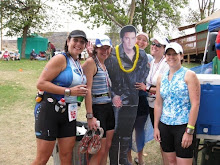Her Sports + Fitness
When she trained for her third Tour du Mont Blanc ultra marathon last summer, Chlo Lanthier-Brandner never was spotted running the roads near her home in Whistler, British Columbia. She was always deep in the woods, blazing up and down old logging trails.
"All of my runs are on trails," Lanthier-Brandner says. "I forget I'm running."
Elite runners are not the only ones lured by trails. More than 5.7 million Americans consider themselves avid trail runners, an increase of 36 percent in the last five years, according to the Outdoor Industry Association. Another 37 million runners hit the trails a few times a year.
Nancy Hobbs, founder of the All-American Trail Running Association and co-author of The Ultimate Guide to Trail Running, explains the growing interest in trail running this way: "There's a real spiritual component to being on the trail. It provides a great physical challenge but in a serene, forgiving environment."
Trail running makes demands on a wider range of muscles than road running, without the repetition injuries of pounding pavement. Ankles, hips, inner and outer thighs and core muscles are engaged for balance. Trails more fully engage the quads, increasing leg strength. Taking on ascents and descents builds stamina, and difficult climbs sharpen mental focus.
Trail-Running Tips
Follow these tips for happy trails wherever you run.1. Run tall. Running, especially uphill, can be exhausting, but if you bend under the effort it's more difficult for the lungs to do their thing. On the uphill, keep an eye at the crest or a few yards ahead, not at your feet. If you're gasping, slow down and pump your arms a little, or if you need to, walk, while keeping your posture tall. Even elite runners will walk a steep hill.
2. Shorten your stride on the way up. And plant your entire foot; climbing on your toes kills your calf muscles. Jump over obstacles. Stepping up on unsteady rocks and roots is not only tiring, it can be hazardous.
3. Be loose on the downhill. Stop braking and allow yourself to fly a little, throwing your arms to the side. But don't flail. If you lose control, slalom from side to side like a skier. Don't lean back or dig in your heels to brake (a guaranteed butt slide). Instead, land quickly and lightly.
4. Plot your moves. View the trail like a chessboard. Plan your steps around bumps, dips, soft sand and fallen trees yards before you reach them.
5. Focus on time, not distance. Don't expect to match your road PR. "Out-and-back routes are great because you can cover the same distance a little bit faster on the way back," Lanthier-Brandner says.
6. Diminish your risks. Run in pairs or let someone know where you're going and when you'll be back. Take plenty of fuel and fluid, a lightweight jacket and a cell phone, which won't always get a signal in the mountains, but might. Uphill runners yield to downhill runners. Yell "trail" well in advance of passing another runner or hiker.
7. Find your balance. Slippery downhills let you know what your legs are made of. Build them up between trail runs with weighted squats and lunges, and build your balance using wobble boards (check out www.performbetter.com for balance gear).
8. Keep your bearings. Things look different coming back than going. Pause to look around when two or more paths diverge from the one you're on. Look at trail signs and identify rocks, trees or landmarks on the horizon.
9. Leave no trace. Even in races, trail runners stow empty wrappers and wouldn't dream of dropping cups like road racers. Stay on marked trails, don't cut switchbacks and go through, not around, puddles to prevent erosion.
10. Feel like a kid again. Crank it on the downhill, hoot and holler, jump into a stream. "Trail running is a chance to get down and dirty, to grab hold of our authentic selves," says trail running coach and sports psychologist Terri Schneider. It'll make all those miles during freezing winters on the treadmill so worth it.
Trail Gear
Essential gear for a trail runner doesn't have to be anything fancier than a crusty pair of trail shoes, an old race tee and socks that will never be white again. But a few other purchases will get you running wild.Shoes. Your favorite brand of road shoe won't necessarily manufacture a good trail runner, or a trail runner that works best for you. Trail running shoes sit lower than road shoes, with a harder midsole to take the impact of the trail. They provide greater ankle support to prevent rolling and more lateral support and flexibility for uneven terrain. They have sturdier, stickier treads. Runners who face stream-crossings or mud should wear trail shoes with drainage holes, waterproof uppers and laces that won't stretch when wet.
Apparel. Trail runners take layering seriously since weather at altitude can change instantly. When the temperature begins to cool, start layering with a running tank, then a long-sleeve tee, both made of a wicking fabric. A breathable, hooded jacket is vital. In warmer weather, stick with loose, wicking shorts. In cold weather opt for snag-proof tights.
Gloves. Wipeouts happen. Lightweight gloves protect hands from gravel burns, stray brambles and chilly air.
Socks. Find what works for you: wool blends, layered micro fiber, toe socks. If you blister, turn them inside out. Go with gray, brown or black.
Sunglasses. Since trails often lead from dark forests to brilliant glades, sunglasses make sense. Even on all-shade trails, glasses protect eyes from branches and clear lenses keep debris from contacts. Lanthier-Brandner recommends orange lenses, which work well in all light, or shades with interchangeable lenses.
Hydro packs. Dehydration happens quickly at altitude so carry water. Hydration packs are necessary for longer runs; bottle belts for shorter trails. Buy packs that are sized for women, with lots of pockets to stash energy gels, bars and a cell phone.





















No comments:
Post a Comment